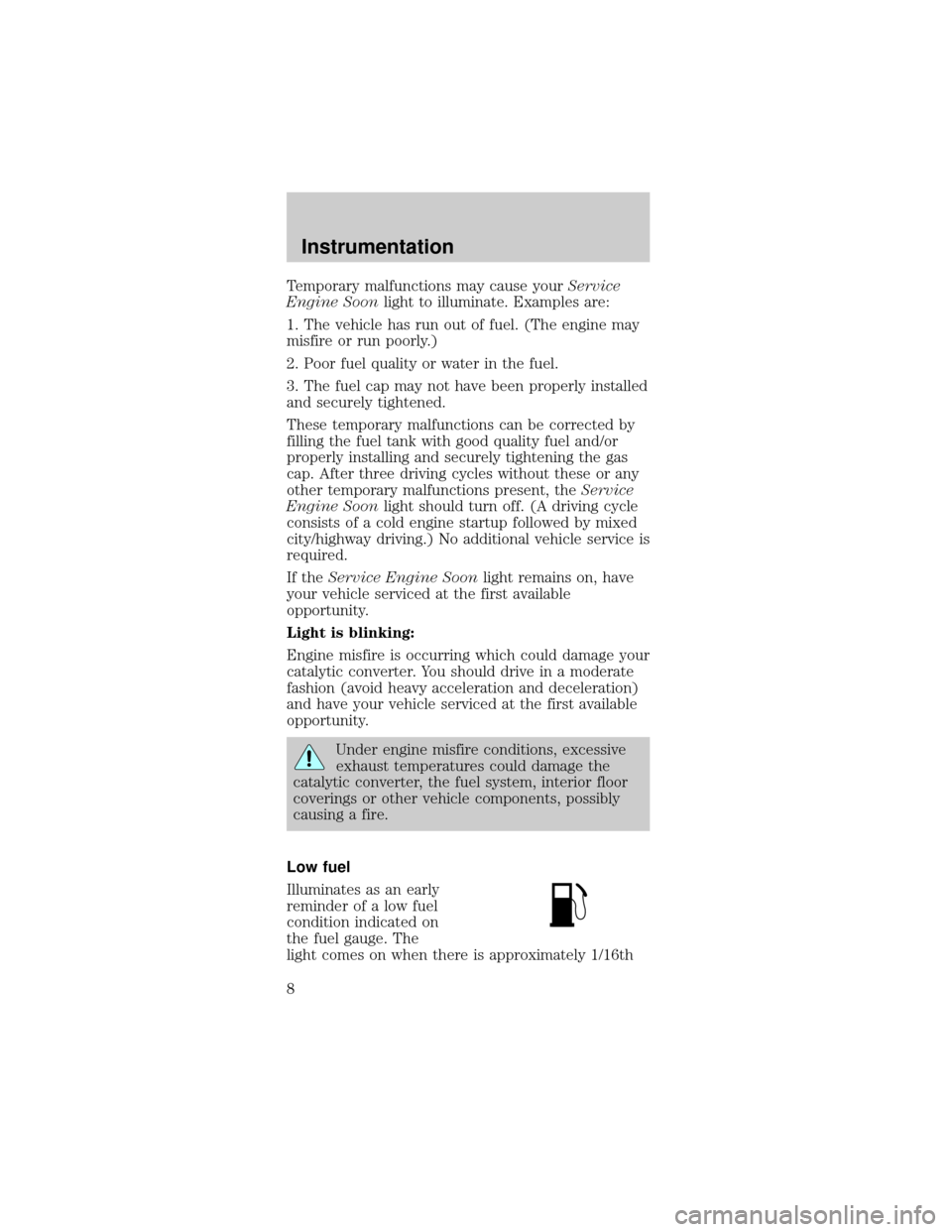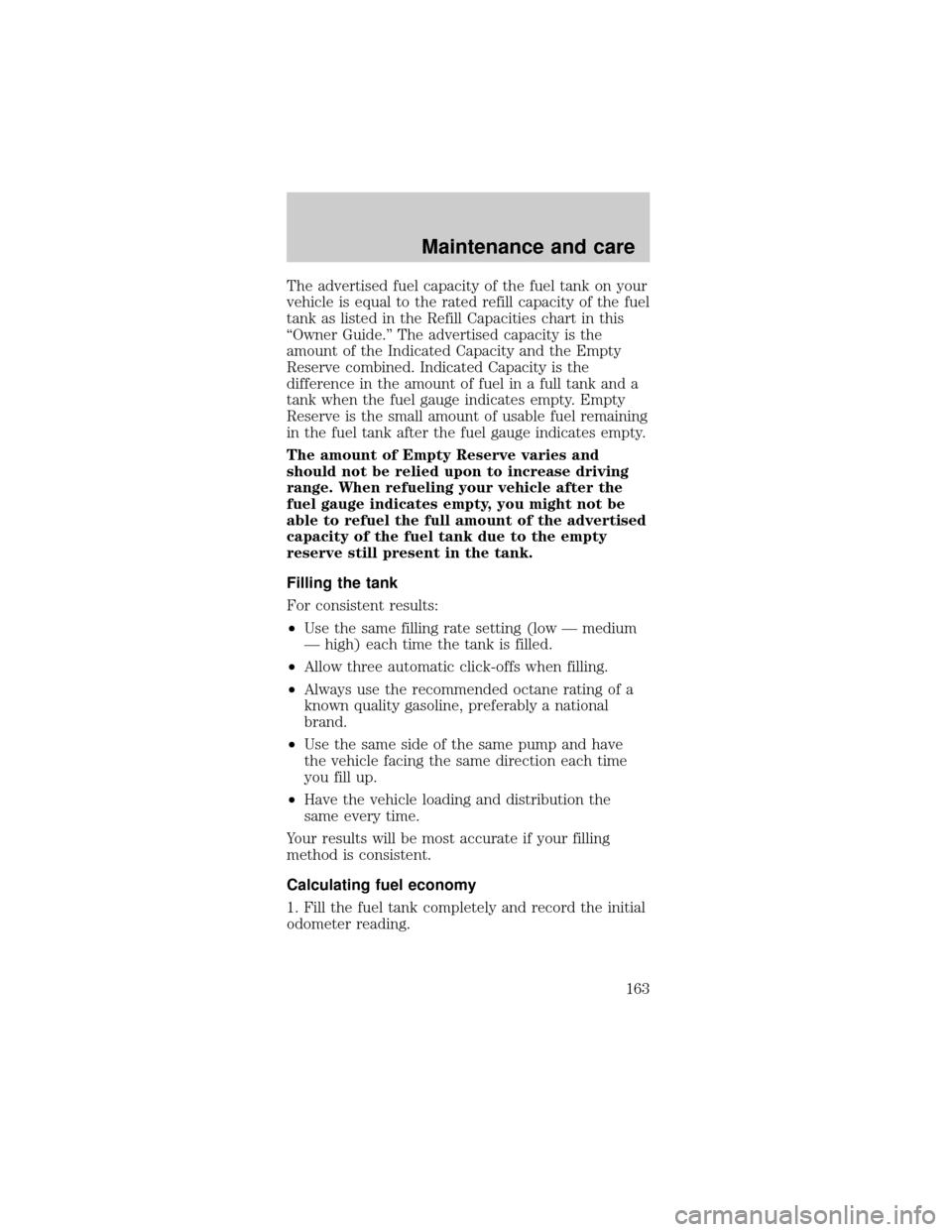fuel cap Mercury Sable 1999 Owner's Manuals
[x] Cancel search | Manufacturer: MERCURY, Model Year: 1999, Model line: Sable, Model: Mercury Sable 1999Pages: 216, PDF Size: 1.33 MB
Page 8 of 216

Temporary malfunctions may cause yourService
Engine Soonlight to illuminate. Examples are:
1. The vehicle has run out of fuel. (The engine may
misfire or run poorly.)
2. Poor fuel quality or water in the fuel.
3. The fuel cap may not have been properly installed
and securely tightened.
These temporary malfunctions can be corrected by
filling the fuel tank with good quality fuel and/or
properly installing and securely tightening the gas
cap. After three driving cycles without these or any
other temporary malfunctions present, theService
Engine Soonlight should turn off. (A driving cycle
consists of a cold engine startup followed by mixed
city/highway driving.) No additional vehicle service is
required.
If theService Engine Soonlight remains on, have
your vehicle serviced at the first available
opportunity.
Light is blinking:
Engine misfire is occurring which could damage your
catalytic converter. You should drive in a moderate
fashion (avoid heavy acceleration and deceleration)
and have your vehicle serviced at the first available
opportunity.
Under engine misfire conditions, excessive
exhaust temperatures could damage the
catalytic converter, the fuel system, interior floor
coverings or other vehicle components, possibly
causing a fire.
Low fuel
Illuminates as an early
reminder of a low fuel
condition indicated on
the fuel gauge. The
light comes on when there is approximately 1/16th
Instrumentation
8
Page 15 of 216

Fuel gauge
Displays approximately
how much fuel is in
the fuel tank (when
the key is in the ON
position). The fuel
gauge may vary slightly
when the vehicle is in
motion. The ignition
should be in the OFF
position while the vehicle is being refueled. When
the gauge first indicates empty, there is a small
amount of reserve fuel in the tank. When refueling
the vehicle from empty indication, the amount of
fuel that can be added will be less than the
advertised capacity due to the reserve fuel.
A minimum of six gallons must be added or removed
from the fuel tank in order for the gauge to
instantaneously update. If less than six gallons is the
change, the gauge will take between five to ten
minutes to update.
EF
Instrumentation
15
Page 158 of 216

If you do not use the proper fuel cap, the
pressure in the fuel tank can damage the
fuel system or cause it to work improperly in a
collision.
The fuel system may be under pressure. If
the fuel cap is venting vapor or if you hear a
hissing sound, wait until it stops before completely
removing the cap.
Automotive fuels can cause serious injury or
death if misused or mishandled.
Observe the following guidelines when handling
automotive fuel:
²Extinguish all
smoking materials
and any open flames
before fueling your
vehicle.
²Always turn off the
vehicle before
fueling.
²Automotive fuels can be harmful or fatal if
swallowed. Fuel such as gasoline is highly toxic
and if swallowed can cause death or permanent
injury. If fuel is swallowed, call a physician
immediately, even if no symptoms are immediately
apparent. The toxic effects of fuel may not be
visible for hours.
²Avoid inhaling fuel vapors. Inhaling too much fuel
vapor of any kind can lead to eye and respiratory
tract irritation. In severe cases, excessive or
prolonged breathing of fuel vapor can cause
serious illness and permanent injury.
Maintenance and care
158
Page 159 of 216

²Avoid getting fuel liquid in your eyes. If fuel is
splashed in the eyes, remove contact lenses (if
worn), flush with water for 15 minutes and seek
medical attention. Failure to seek proper medical
attention could lead to permanent injury.
²Fuels can also be harmful if absorbed through the
skin. If fuel is splashed on the skin and/or
clothing, promptly remove contaminated clothing
and wash skin thoroughly with soap and water.
Repeated or prolonged skin contact with fuel
liquid or vapor causes skin irritation.
²Be particularly careful if you are taking
ªAntabuseº or other forms of disulfiram for the
treatment of alcoholism. Breathing gasoline
vapors, or skin contact could cause an adverse
reaction. In sensitive individuals, serious personal
injury or sickness may result. If fuel is splashed
on the skin, promptly wash skin thoroughly with
soap and water. Consult a physician immediately
if you experience an adverse reaction.
Fuel Filler Cap
Your fuel tank filler cap has an indexed design with
a one-eighth turn on/off feature.
When fueling your vehicle:
1. Turn the engine off.
2. Carefully turn the filler cap counterclockwise 1/8
of a turn until it stops.
3. Pull to remove the cap from the fuel filler pipe.
4. To install the cap, align the tabs on the cap with
the notches on the filler pipe.
5. Turn the filler cap clockwise 1/8 of a turn until it
stops.
If the ªService Engine Soon/Check Engineº indicator
comes on and stays on when you start the engine,
the fuel filler cap may not be properly installed.
Turn off the engine, remove the fuel filler cap and
reinstall it being careful to align the cap properly.
Maintenance and care
159
Page 160 of 216

If you must replace the fuel filler cap, replace
it with a genuine Ford or Motorcraft part. The
customer warranty may be void for any damage
to the fuel tank or fuel system if a genuine
Ford or Motorcraft fuel filler cap is not used.
The fuel system may be under pressure. If
the fuel filler cap is venting vapor or if you
hear a hissing sound, wait until it stops before
completely removing the fuel filler cap. Otherwise,
fuel may spray out and injure you or others.
If you do not use the proper fuel filler cap,
the pressure in the fuel tank can damage
the fuel system or cause it to work improperly in a
collision.
Choosing the right fuel
Use only UNLEADED FUEL. The use of leaded fuel
is prohibited by law and could damage your vehicle.
Do not use gasolines containing methanol. It can
damage critical fuel systems components.
Vehicles certified to meet California emission
standards (indicated on the underhood Vehicle
Emissions Control Information label) are designed to
operate on California cleaner-burning, low-sulfur
gasolines. If you have a California-certified vehicle
and California cleaner-burning gasoline is not
available when you refuel, your engine should
perform adequately. However, the performance of
the emission control devices and systems may be
adversely affected. In New York and Massachusetts,
which have adopted California's emission standards
without requiring the sale of California
cleaner-burning gasoline, repairs to correct the
effects of using non-California fuel may not be
covered by the emissions warranty.
Maintenance and care
160
Page 163 of 216

The advertised fuel capacity of the fuel tank on your
vehicle is equal to the rated refill capacity of the fuel
tank as listed in the Refill Capacities chart in this
ªOwner Guide.º The advertised capacity is the
amount of the Indicated Capacity and the Empty
Reserve combined. Indicated Capacity is the
difference in the amount of fuel in a full tank and a
tank when the fuel gauge indicates empty. Empty
Reserve is the small amount of usable fuel remaining
in the fuel tank after the fuel gauge indicates empty.
The amount of Empty Reserve varies and
should not be relied upon to increase driving
range. When refueling your vehicle after the
fuel gauge indicates empty, you might not be
able to refuel the full amount of the advertised
capacity of the fuel tank due to the empty
reserve still present in the tank.
Filling the tank
For consistent results:
²Use the same filling rate setting (low Ð medium
Ð high) each time the tank is filled.
²Allow three automatic click-offs when filling.
²Always use the recommended octane rating of a
known quality gasoline, preferably a national
brand.
²Use the same side of the same pump and have
the vehicle facing the same direction each time
you fill up.
²Have the vehicle loading and distribution the
same every time.
Your results will be most accurate if your filling
method is consistent.
Calculating fuel economy
1. Fill the fuel tank completely and record the initial
odometer reading.
Maintenance and care
163
Page 180 of 216

MOTORCRAFT PART NUMBERS
Component 3.0L V6 Vulcan
engine3.0L V6
Duratec engine
Air filter
elementFA-1630 FA-1630
Fuel filter FG-800-A FG-800-A
Battery
(standard)BXT-58R BXT-36R
Battery
(optional)BXT-36R N/A
Oil filter FL-400-S FL-820-S
PCV valve EV-228 EV-152
Spark plugs* AWSF-32PP** AWSF-32F
* Refer to Vehicle Emissions Control Information
(VECI) decal for spark plug gap information.
** If a spark plug is removed for inspection, it must
be reinstalled in the same cylinder. Cylinders No. 1,
2 and 3 have a ªPGº suffix. Cylinders No. 4, 5 and 6
have a ªPº suffix. If a spark plug needs to be
replaced, use only spark plugs with the service part
number suffix letter9PP9as shown on the engine
decal.
Capacities and specifications
180
Page 181 of 216

REFILL CAPACITIES
Fluid Ford Part
NameAppli-
cationCapacity
Brake fluid High Per-
formance
DOT 3
Motor
Vehicle
Brake
FluidAll Fill to line on
reservoir
Engine
coolant
1Premium
Engine
Coolant3.0L V6
Vulcan
engine11.0L
(11.6 quarts)
3.0L V6
Duratec
engine10.0L
(10.6 quarts)
Engine oil
(includes
filter
change)Motorcraft
5W-30
Super
Premium
Motor Oil3.0 V6
Vulcan
engine4.25L
(4.5 quarts)
3.0L V6
Duratec
engine5.2L
(5.5 quarts)
Fuel tank
capacityN/A All
vehicles60.6L
(16.0 gallons)
Power
steering
fluidMotorcraft
MERCONt
AT F3.0L V6
Vulcan
engineKeep in FULL
range on
dipstick
3.0L V6
Duratec
engineFill to line on
reservoir
Capacities and specifications
181
Page 184 of 216

ItemsFord Part
Name or
equivalentFord Part
NumberFord
Specifi-
cation
Engine
coolantFord
Premium
Engine
CoolantE2FZ-
19549-AA
(in Oregon,
F5FZ-
19549-CC,
in Canada,
Motorcraft
CXC-10)ESE-
M97B44-A
Power
steering
fluidMotorcraft
MERCONt
AT FXT-2-QDX MERCONt
Windshield
washer
fluidUltra-Clear
Windshield
Washer
ConcentrateC9AZ-
19550-ACESR-
M17P5-A
ENGINE DATA
Engine 3.0L V6
Vulcan engine3.0L V6
Duratec
engine
Cubic inches 182 183
Horsepower 145 @
5250 rpm200 @
5750 rpm
Torque 170 lb.-ft. @
3250 rpm200 lb.-ft. @
4500 rpm
Recommended
fuel87 octane 87 octane
Firing order 1-4-2-5-3-6 1-4-2-5-3-6
Spark plug gap 1.07-1.17 mm
(0.042-
0.046 inch)1.3-1.4 mm
(0.052-
00.056 inch)
Ignition system EDIS EDIS
Compression
ratio9.3:1 10:1
Capacities and specifications
184
Page 215 of 216

Item Information
Recommended fuel Unleaded fuel only ±
87 octane
Fuel tank capacity 60.6L (16 gallons)
Engine oil capacity
(including filter
change)-3.0L V6 Vulcan
engine4.25L (4.5 quarts) Use
Motorcraft 5W30 Super
Premium Motor Oil,
Ford specification
WSS-M2C153-G.
Engine oil capacity
(including filter
change)-3.0L V6
Duratec engine5.2L (5.5 quarts) Use
Motorcraft 5W30 Super
Premium Motor Oil,
Ford specification
WSS-M2C153-G.
Tire size and pressure Refer to Certification
Label. Inflate temporary
spare to 414 kPa
(60 psi).
Hood release Pull handle under the
left side of the
instrument panel.
Coolant capacity (3.0L
V6 Vulcan engine)
111.0L (11.6 quarts)
Coolant capacity (3.0L
V6 Duratec engine)
110.0L (10.6 quarts)
Power steering fluid
capacity-3.0L V6 Vulcan
engineKeep in FULL range on
dipstick.
Power steering fluid
capacity-3.0L V6
Duratec engineFill to line on reservoir.
Filling station information
215